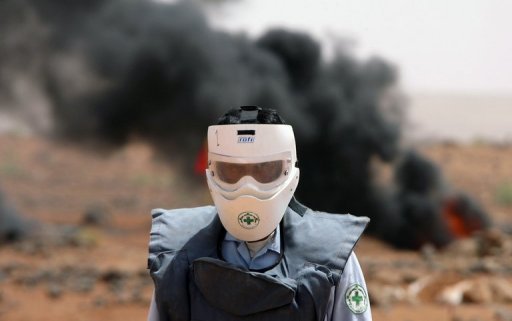
(AFP) – Geneva— The Syrian regime was the only government in the world to lay new landmines this year, campaigners said Thursday as they issued an annual report on the use and effect of the devastating weapons.Mark Hiznay, the editor of the report for the International Campaign to Ban Landmines (ICBL), said the finding is a significant change from last year, when four governments laid mines, and represents the lowest number since the Ottawa Mine Ban Treaty was signed in 1997.
“This represents a milestone for us: having only one country using antipersonnel mines,” he told reporters in Geneva at the unveiling of the 2012 Landmine Monitor report.
But even though only one government laid the lethal mines this year, the explosives were still used by non-state armed groups in six countries — Afghanistan, Colombia, Myanmar, Pakistan, Thailand and Yemen — up from four countries last year, the report said.
The ICBL’s report hailed record high levels of funding for mine clearance and a dramatic reduction in the number of people killed by the explosive devices over the past decade.
These developments are “a testament to the achievements of the Mine Ban Treaty over the past 15 years and that’s the good news,” said Hiznay, who is also a senior arms researcher for Human Rights Watch.
Syria was also among the four countries singled out in last year’s report, when the governments of Israel, Libya and Myanmar were found to have used landmines.
In Syria, at least 19 people were killed by the explosive devices in border-crossing areas during the first five months of the year, including a Landmine Monitor source who died while crossing a mine field in March, according to ICBL.
There had also been an incident in October, when Syrian troops abandoning a military position near the village of Khirbet al-Jouz close to the Turkish border had left behind up to 200 landmines, Hiznay said.
“Eventually, the villagers began finding them the hard way,” he said.
The Syrian regime appeared to be using old stockpiles of the weapons produced by the Soviet Union in the 1980s, he said, adding that “there was “no indication of recent supplies.”
While the number of countries laying new landmines might be low, 59 countries and six other areas were confirmed to have been affected by the deadly explosives this year, and mines were suspected in another 12 countries, the report said.
The ICBL said 4,286 people were killed by landmines worldwide last year — or nearly 12 deaths a day, compared to 32 in 2001.
The steady decrease in annual casualty rates in some of the world’s most mine-affected countries, like Afghanistan and Cambodia, had however been offset by a “significant increase” in mine-linked deaths in countries like Libya, Sudan and Syria.
In Syria, the number of casualties had jumped from nine in 2010 to 20 last year, the ICBL said.
The organisation, which won the Nobel Peace Prize in 1997 for its efforts to rid the world of landmines, said a growing number of governments were signing on to the treaty, which now counts 160 signatory states.
International and national funding for mine clearing activities meanwhile reached an all-time high last year of around $662 million (511 million euros), ICBL said, while noting that funding for helping landmine survivors had fallen sharply to just $30 million in 2011.
As for landmine production, only India, Myanmar, Pakistan and South Korea appeared to still be actively producing antipersonnel mines, the report showed.
However, another eight countries still reserve the right to produce such weapons: China, Cuba, Iran, North Korea, Russia, Singapore, the United States and Vietnam.
The ICBL report came ahead of a five-day meeting in Geneva next week of signatory countries to the Ottawa Treaty.




